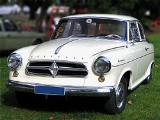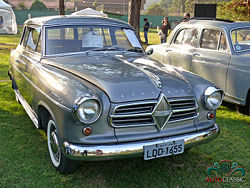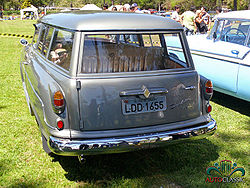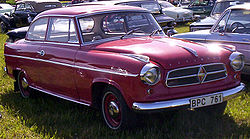
Borgward Isabella
Encyclopedia
.jpg)
jpg.jpg)



Bremen
The City Municipality of Bremen is a Hanseatic city in northwestern Germany. A commercial and industrial city with a major port on the river Weser, Bremen is part of the Bremen-Oldenburg metropolitan area . Bremen is the second most populous city in North Germany and tenth in Germany.Bremen is...
based auto-manufacturer Carl F. W. Borgward GmbH
Borgward
Borgward was a German automobile manufacturer founded by Carl F. W. Borgward . The company was based in Bremen...
from 1954-1962. Initially, the car was badged — like its predecessor — as the Hansa 1500, but within the company it was known from the beginning by the code name, Isabella (not after Carl Borgward
Carl F. W. Borgward
Carl Friedrich Wilhelm Borgward was a German engineer and designer and the creator of the Borgward group, based in Bremen. -Biography:...
's wife whose name was Elisabeth), and cars produced after 1957 bore the ‘Isabella’ name, inscribed eye catchingly within the rhombus at the centre of the front grille: in retrospect, the car produced from 1954 is known as the Isabella to differentiate it from the (first) Hansa 1500/1800 which the company produced from 1949-1954.
Despite its aspirational positioning in the marketplace, the Isabella had a smaller engine (and was marginally shorter) than its immediate predecessor
Borgward Hansa 1500
The Hansa 1500 is a medium sized saloon that was manufactured by the Bremen based auto-manufacturer Carl F. W. Borgward GmbH. The strikingly modern car was presented at the Geneva Motor Show in March 1949...
. Late in 1952, the firm had launched their six cylinder Hansa 2400
Borgward Hansa 2400
The Borgward Hansa 2400 is a large six-cylinder saloon first presented in 1952 and manufactured by the Bremen based auto-manufacturer Carl F. W. Borgward GmbH from 1953 to 1959. The car was launched as a fast back sedan: a longer-wheelbase notchback version appeared a year later...
model. The larger car never found many buyers; but in 1954, it made commercial sense to keep the two models from competing too directly with each other.
The Isabella at launch
11,150 Isabellas were produced in 1954, an early indicator that commercially this would be the most successful Borgward ever. The early cars enjoyed an enthusiastic reception in the market place. Unfortunately, early models were afflicted by teething troubles, reflecting a rushed development schedule, and the marketplace would later prove unforgiving as Borgward's Stuttgart based rivalMercedes-Benz
Mercedes-Benz is a German manufacturer of automobiles, buses, coaches, and trucks. Mercedes-Benz is a division of its parent company, Daimler AG...
, Daimler-Benz
Daimler-Benz
Daimler-Benz AG was a German manufacturer of automobiles, motor vehicles, and internal combustion engines; founded in 1926. An Agreement of Mutual Interest - which was valid until year 2000 - was signed on 1 May 1924 between Karl Benz's Benz & Cie., and Daimler Motoren Gesellschaft, which had...
demonstrated that new models did not have to involve customers in such problems.
The advertised launch price of DM 7,265 was higher than that of competitor family sedans from Opel
Opel Rekord
The Opel Rekord was a large family car/executive car which was built in several generations by the German car manufacturer Opel.-Naming:The Rekord name evolved into the main name of the model; at first the name was used in close relationship with the Opel Olympia name, which pre-dated the Rekord...
and Ford
Ford Taunus
The Ford Taunus is a family car sold by Ford in Germany and other countries. Models from 1970 onward were similar to the Ford Cortina in the United Kingdom...
, but significantly less than Mercedes Benz was asking for their 180 model. In view of the car's spacious cabin and impressive performance, the pricing was perceived as very competitive. A road test at launch reported a maximum speed of 130 km/h (80.8 mph) and fuel consumption of 8.4 l/100 km. The testers described the modern structure of the car in some detail: they particularly liked the wide cabin with its large windows, and they commended the effectiveness of the brakes. The inclusion of a cigarette lighter and a clock also attracted favourable mention. Unlike the Mercedes 180 however, (and unlike its predecessor) the Isabella was only delivered with two-doors.
The Isabella was constructed without a separate chassis, applying the monocoque
Monocoque
Monocoque is a construction technique that supports structural load by using an object's external skin, as opposed to using an internal frame or truss that is then covered with a non-load-bearing skin or coachwork...
technique which during the 1950s was becoming the norm. Like its predecessor, the car was designed with a modern ponton
Ponton (automobile)
Ponton or Pontoon styling refers to a 1930s-1960s design genre — ultimately the precursor of modern automotive styling. The trend emerged as distinct running boards and fully articulated fenders became less common and bodywork began to enclose the full width and uninterrupted length of a car...
, three-box
Three-box styling
Three-box design is a broad automotive styling term describing a coupé, sedan, notchback or hatchback where — when viewed in profile — principal volumes are articulated into three separate compartments or boxes: engine, passenger and cargo....
design, but the line of the Isabella was more curvaceous than that of the first Hansa, and the car’s body made greater use of chrome trim. Ground clearance was 6.9".
The Isabella featured a swing axle at the back: it was supported by coil springs on all four wheels. The four-cylinder 1493 cc engine had a claimed power output of 60 bhp, and was connected by means of a then innovative hydraulic clutch to the four speed full synchromesh gear box. Gear changes were effected by means of a column mounted lever.
Variants
A year after presenting the saloon, Borgward presented the Isabella estate version.Also introduced in 1955 was a two door cabriolet, known as the Isabella TS and featuring a more powerful 75 bhp motor. Production of the cabriolet was contracted to the firm Karl Deutsch in Cologne
Cologne
Cologne is Germany's fourth-largest city , and is the largest city both in the Germany Federal State of North Rhine-Westphalia and within the Rhine-Ruhr Metropolitan Area, one of the major European metropolitan areas with more than ten million inhabitants.Cologne is located on both sides of the...
: converting an early monocoque design to a cabriolet necessitated considerable modification in order to achieve the necessary structural rigidity, and the resulting cost was reflected in a much higher selling price for this version.
Initial sales volumes were not maintained. Responding to a sales decline of almost a third in 1955 and 1956, Carl Borgward
Carl F. W. Borgward
Carl Friedrich Wilhelm Borgward was a German engineer and designer and the creator of the Borgward group, based in Bremen. -Biography:...
decided to produce a more beautiful Isabella with a shortened roof line. The Borgward Isabella Coupé was developed, and the four hand built prototypes were well received by the press. Borgward gave one of these prototypes to his wife, Elisabeth, who would continue to drive it into the 1980s. Commercial production of the coupé, powered by the more powerful TS version of the engine first seen in the cabriolet, commenced in January 1957. The coupe appears to have achieved its marketing objective of further distancing the Isabella’s image from similarly sized competitors from Opel and Ford. By 1958, the more powerful 75 bhp TS motor had also found its way into the more upmarket Isabella saloon and estate versions.
Vehicles were exported to several markets, including Australia and Malaya, where only 10 examples were sold.
The Isabella in competition
English Racing driver and tuner Bill Blydenstein raced a Borgward Isabella in the 1950s with some success.The end
At the time of Borgward’s controversial bankruptcy in 1961, the firm carried a substantial stock of unsold Isabellas. Nevertheless, the model's production at the Bremen plant continued until 1962, suggesting that overstocking had not been restricted to finished vehicles. By the end, 202,862 Isabellas had rolled off the Borgward production line which was nevertheless an impressive volume in the 1950s: overall, and despite being hit by falling demand in the economic slump that briefly hit Germany in the early 1960s, the car is believed to have been the firm's most lucrative model by a very considerable margin.Borgward enjoyed a brief afterlife: the production line was sold and shipped to Mexico where later during the 1960s the P100 (Big Six) was produced. The Isabella was never produced in Mexico. Back in the German market, BMW’s
BMW
Bayerische Motoren Werke AG is a German automobile, motorcycle and engine manufacturing company founded in 1916. It also owns and produces the Mini marque, and is the parent company of Rolls-Royce Motor Cars. BMW produces motorcycles under BMW Motorrad and Husqvarna brands...
stylish new 1500, launched by the Bavarians in 1961, convincingly filled the niche vacated by the Isabella, and was credited by at least one commentator with having rescued BMW itself from insolvency. In Argentina, the Isabella was manufactured from 1960 to 1963 by Dinborg, a local subsidiary of Borgward. 999 Isabellas were made in Buenos Aires.
Sources and further reading
- Peter Kurze: „Autos aus Bremen“, Band 3, Verlag Peter Kurze, Bremen 2001, ISBN 3980697738
- Völker, Heinrich: Der Weg zur Borgward Isabella - Unbekanntes aus der Versuchsabteilung - Bremen: Verlag Peter Kurze 2003 – ISBN 978-3-927485-27-3
- Georg Schmidt: „Borgward“, Motorbuch Verlag, Stuttgart 1986, ISBN 3879436797
- „Motor-Klassik“, Heft 1/2004, Vereinigte Motor-Verlage, Stuttgart

